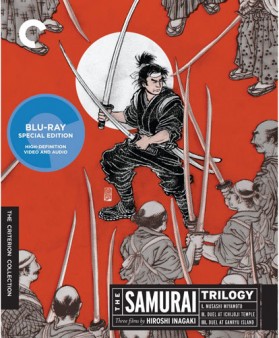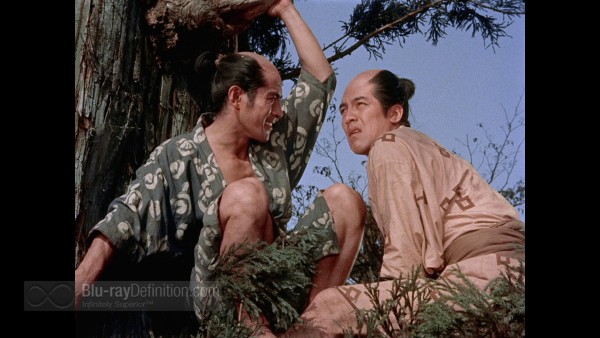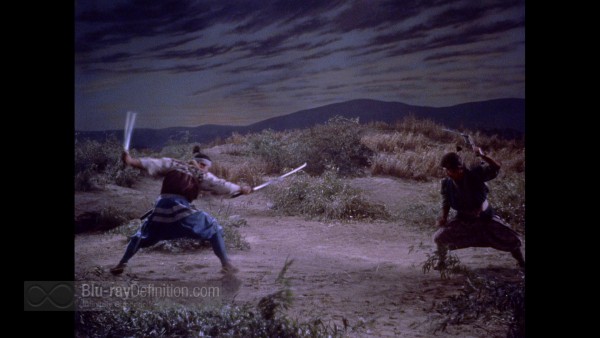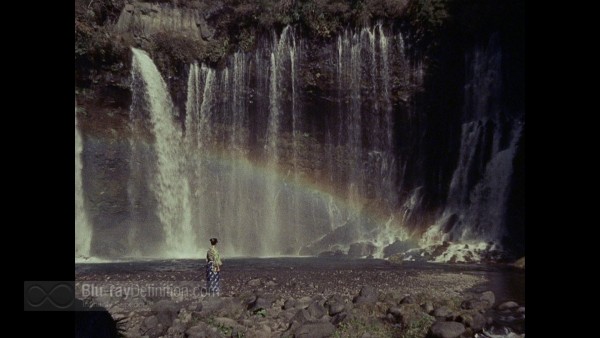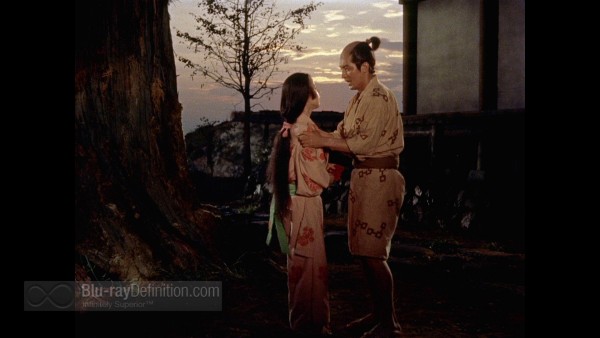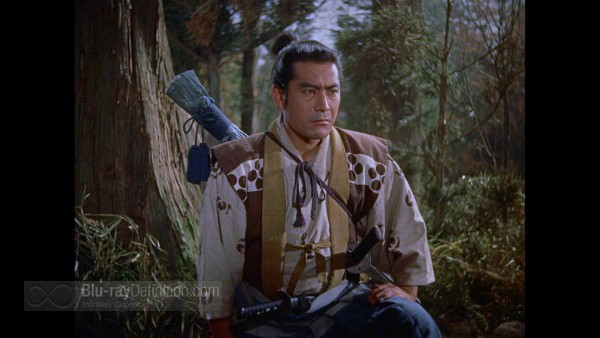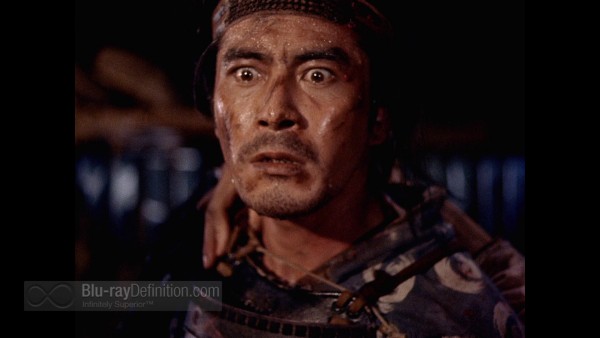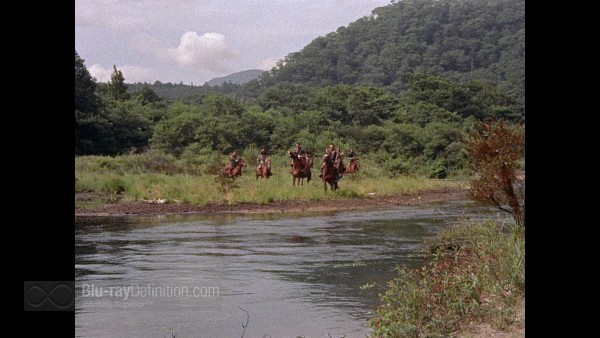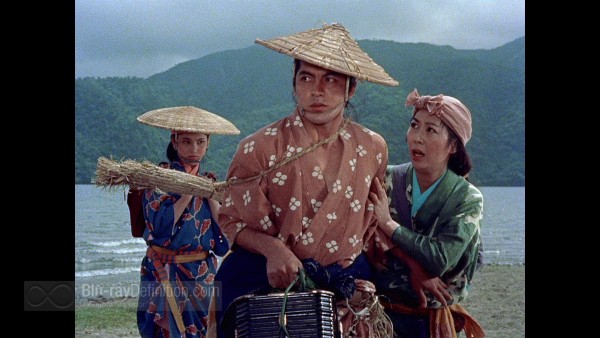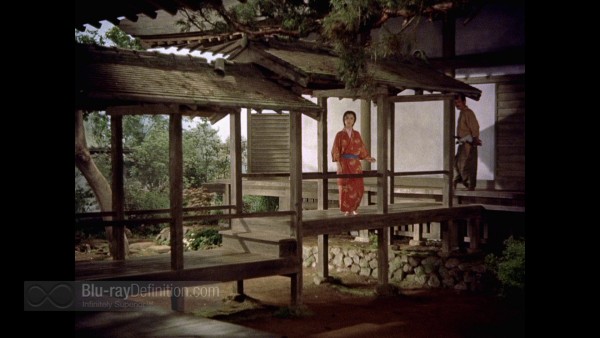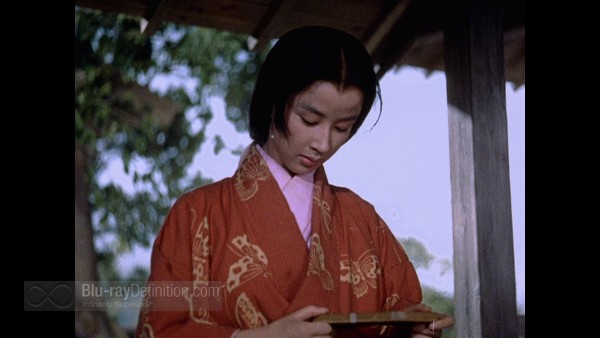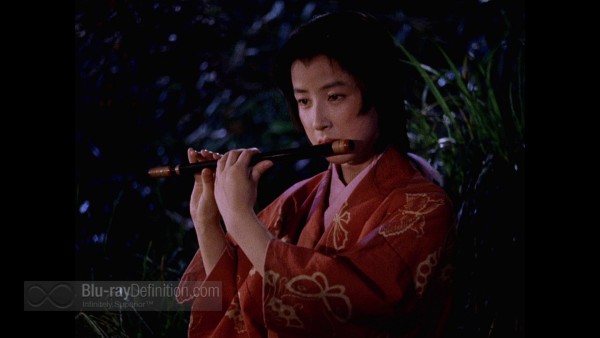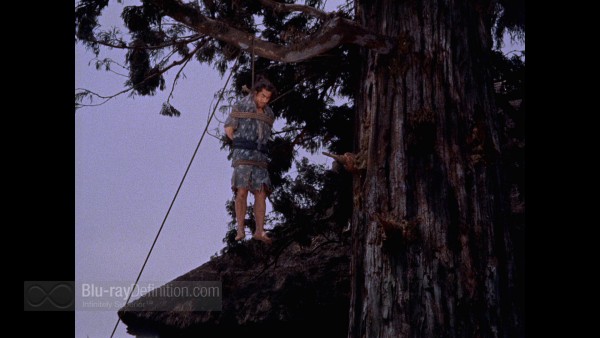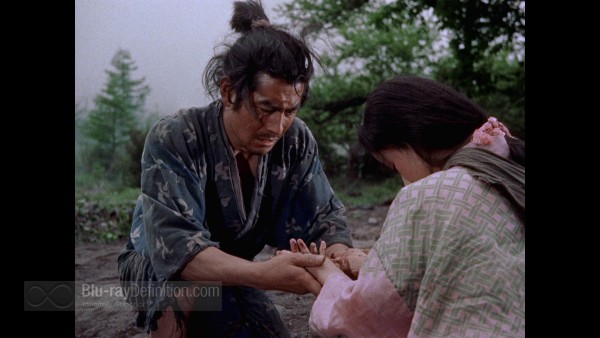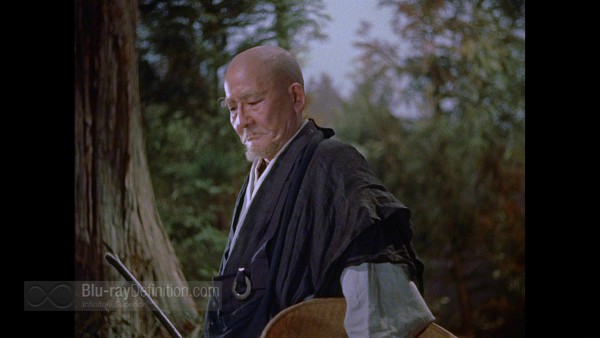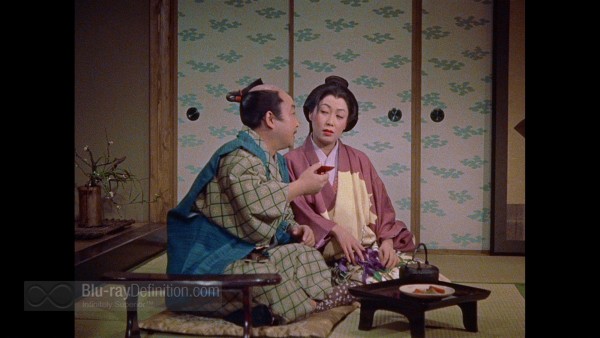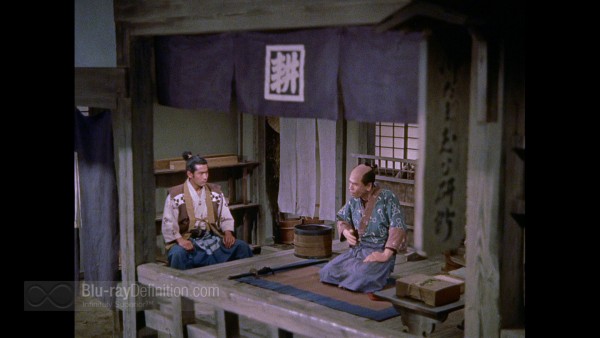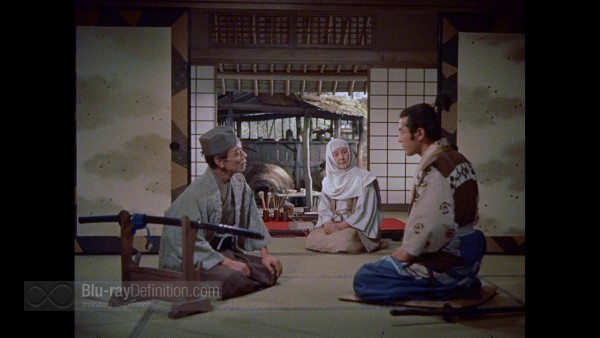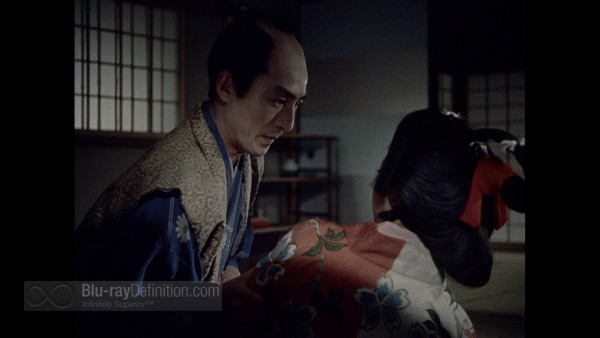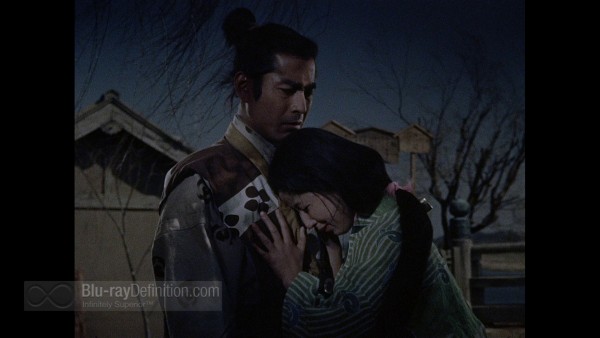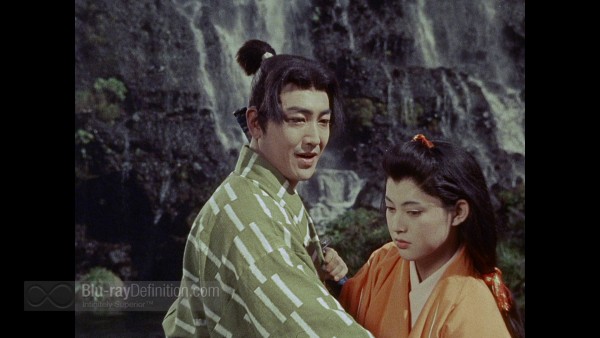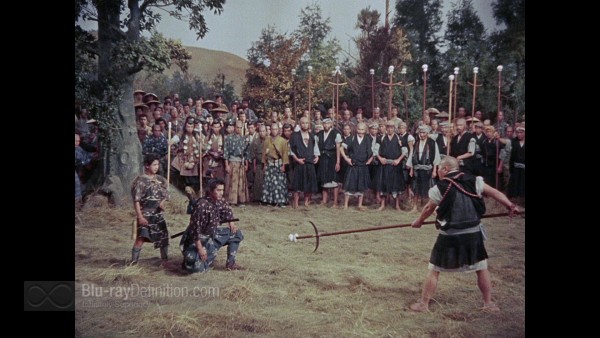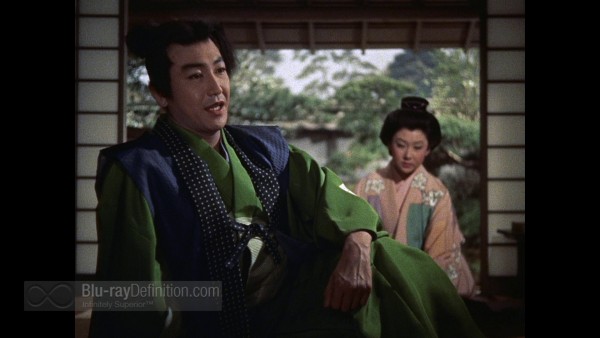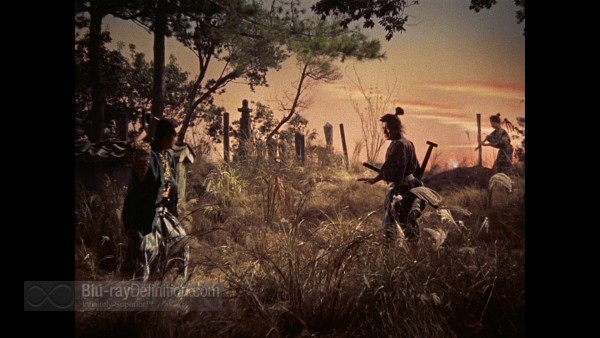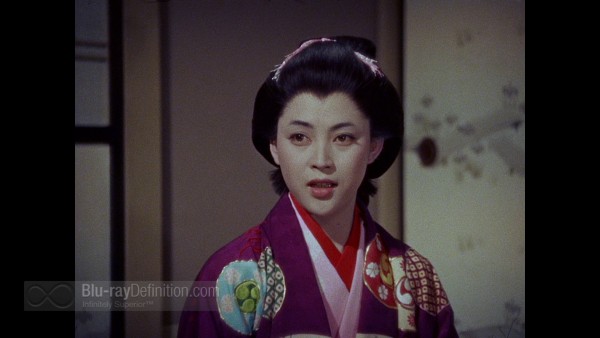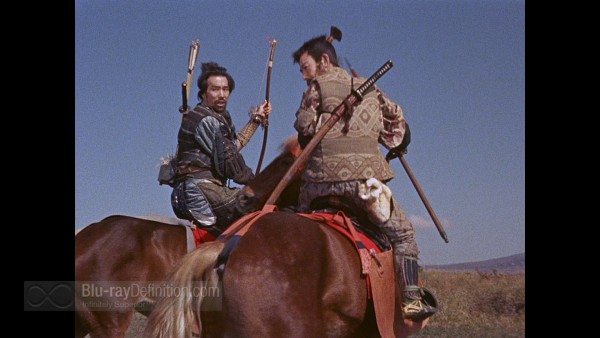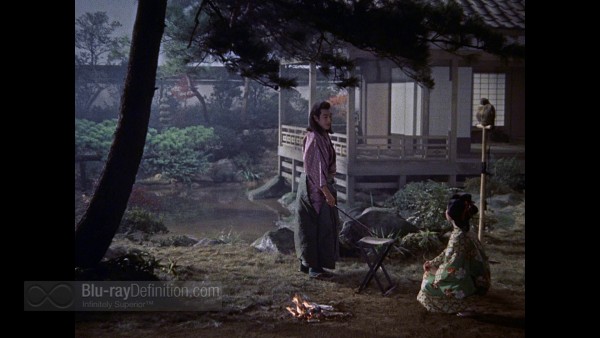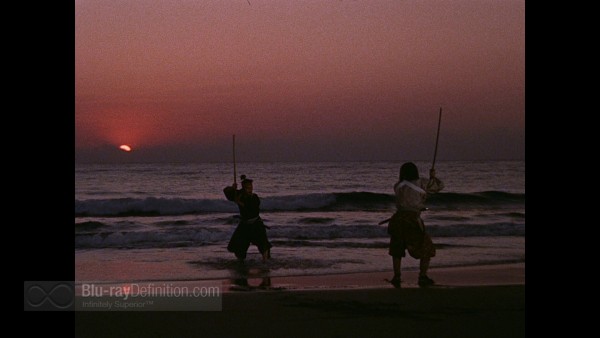- Aspect Ratio: 1.33:1
- Video Codec: AVC/MPEG-4
- Resolution: 1080p/24 (23.976Hz)
- Audio Codec: Japanese LPCM 1.0 (48kHz/24-bit)
- Subtitles: English
- Subtitles Color: White
- Region: A (Region-Locked)
- Rating: Not Rated
- Run Time: 93 Mins. (I), 103 Mins. (II), 104 Mins. (III)
- Discs: 2 (2 x Blu-ray)
- Studio: Criterion Collection
- Blu-ray Release Date: June 26, 2012
- List Price: $69.95
–
Overall
[Rating:4/5]
The Films
[Rating:5/5]
Video Quality
[Rating:4.5/5]
Audio Quality
[Rating:4/5]
Supplemental Materials
[Rating:2.5/5]
Click thumbnails for high-resolution 1920X1080p screen captures
(All TheaterByte screen captures are lightly compressed with lossy JPEG at 100% quality setting and are meant as a general representation of the content. They do not fully reveal the capabilities of the Blu-ray format)
–
The Films
[Rating:5/5]
Releasing to theaters in Japan over 1954, ’55, and ’56, director Inagaki Hiroshi’s Samurai Trilogy was actually a color remake of his trilogy from 1940 and 1942 about the famous folk hero Miyamoto Musashi. In instant success upon its release in 1954, the first part, Samurai I: Musashi Miyamoto, was actually released in a really big year for its studio, Toho, which also saw the releases of Kurosawa’s Seven Samurai and Gojira.
One of the great chambara (swordplay; チャンバラ) classics of Japanese cinema, Inagaki’s Samurai Trilogy is based on the novel Musashi by Yoshikawa Eiji (and a subsequent play based on that novel). The Yoshikawa novel and Inagaki’s film follows the life of the popular folk hero and ronin from his teens as an outcast in the rural village of Miyamoto through to the age of twenty-nine and his famous defeat of Sasaki Kojiro at Ganryu Island.
Samurai I specifically deals with Musashi’s early years and the beginning of his journey towards becoming an exceptionally skilled swordsman as he is driven from his home village of Miyamoto. Samurai II begins to incorporate some elements of romance with the beautiful Otsu (Yachigusa Kaoru) and Akemi (Okada Mariko) both hopelessly vying for the relentlessly rigid Musashi’s love and attention. It culminates in his legendary duel at Ichijoji Temple. Finally, Samurai III examines the rivalry between Musashi and Sasaki Kojiro, ending in their climactic duel at Ganryu Island.
Inagaki’s film, unlike the companion samurai film from Toho of the same year by Kurosawa, was a spectacle of color – Kurosawa, of course, would not film in color until 1970. It is filled with beautiful hand-drawn backgrounds and a marvelous sense of theatre that links back in many ways to kabuki theater, especially in the intensely choreographed swordplay scenes.
Inagaki is also preoccupied with the metaphor of fluidity in Samurai Trilogy, be it the imagery of rice bending gently in the breeze, or the traditional dying process of kimonos in a stream mimicking another image of reeds flowing in the current. It’s like metaphor for Musashi’s perpetual motion forward, his constant search for improvement not only of his skill in the sword, but to be a well rounded person in the arts and literature.
At the heart of Samurai Trilogy is the brilliant performance by Mifune Toshiro as the legendary swordsman. His gravitas in this role is without question just as his folly in Seven Samurai helps relieve some of that film’s seriousness.
Video Quality
[Rating:4.5/5]
These new high definition digital transfers were created on a Spirit Datacine from 35mm low-contrast prints struck from the original camera negatives. Color corrections inherent in the original Eastmancolor stock were undertaken and thousands of instances of dirt, debris, scratches, splices, and warps were manually removed musing MTI’s DRS and Pixel Farm’s PFClean, while Image Systems’ Phoenix and PFClean were also used for small dirt, grain, noise reduction, jitter, and flicker.
The transfer from Criterion looks marvelous, despite early issues in each part of the trilogy during the title sequences where there are obvious signs of damage. That all dissipates quickly, and then Samurai Trilogy, throughout each film, looks quite detailed and film-like with beautiful colors and strong contrast.
Audio Quality
[Rating:4/5]
The monaural soundtracks are provided in LPCM 1.0 (48kHz/24-bit); there isn’t much to say about them other than clipping is minimal and there is a good delineation between the dialogue and sound effects.
Supplemental Materials
[Rating:2.5/5]
William Scott Wilson gives very interesting and informed video commentaries on each film in the trilogy; I recommend watching them if you are disinclined to reading the even more informative booklet.
The supplements:
- Samurai I: Musashi Miyamoto:
- On Musashi Miyamoto, Part I (1.78:1; 1080p/24; 00:08:37) — The character Musashi Miyamoto was inspired by the historical figure of the same name. In this interview, conducted by the Criterion Collection in 2012, translator and historian William Scott Wilson (The Lone Samurai) discusses the real-life events corresponding to the time frame of Samurai I: Musashi Miyamoto.
- Trailer (1.33:1; 1080i/60)
- Samurai II: Duel at Ichijoji Temple:
- On Musashi Miyamoto, Part II (1.78:1; 1080p/24; 00:07:13) – The character Musashi Miyamoto was inspired by the historical figure of the same name. In this interview, conducted by the Criterion Collection in 2012, translator and historian William Scott Wilson (The Lone Samurai) discusses the real-life events corresponding to the time frame of Samurai II: Duel at Ichijoji Temple.
- Trailer (1.33:1; 1080i/60)
- Samurai III: Duel at Ganryu Island:
- On Musashi Miyamoto, Part III (1.78:1; 1080p/24; 00:09:52) – The character Musashi Miyamoto was inspired by the historical figure of the same name. In this interview, conducted by the Criterion Collection in 2012, translator and historian William Scott Wilson (The Lone Samurai) discusses the real-life events corresponding to the time frame of Samurai III: Duel at Ganryu Island.
- Trailer (1.33:1; 1080i/60)
- Booklet: The illustrated booklet contains two informed essays, “Musashi Mifune” by Stephen Prince, covering the work of Inagaki Hiroshi and The Samurai Trilogy in particular; and “The Book of Five Rings” by William Scott Wilson explains the defining philosophical literary work of Musashi. Additionally there are film credits and information on the transfer.
The Definitive Word
Overall:
[Rating:4/5]
The Samurai Trilogy is without question one of the most enjoyable chambara sagas I have ever hd the pleasure of watching. It easily rivals anything from the master Kurosawa. Its stunning visuals, brilliant acting and wonderful choreography make it absolutely riveting and easy to watch in one sitting – as I did. Criterion Collection have also done a A+ job on bringing these films to Blu-ray and are to be commended. Highly recommended.
Additional Screen Captures
[amazon-product align=”center”]B007N5YJZM[/amazon-product]
Purchase The Samurai Trilogy [Criterion Collection] on Blu-ray at CD Universe
Shop for more Blu-ray titles at Amazon.com
Samurai I: Musashi Miyamoto:
Samurai II: Duel at Ichijoji Temple:
Samurai III: Duel at Ganryu Island:
–
[amazon-product]B007N5YJZM[/amazon-product]
Purchase The Samurai Trilogy [Criterion Collection] on Blu-ray at CD Universe
Shop for more Blu-ray titles at Amazon.com
Overall
[Rating:4/5]
The Films
[Rating:5/5]
Video Quality
[Rating:4.5/5]
Audio Quality
[Rating:4/5]
Supplemental Materials
[Rating:2.5/5]
–


